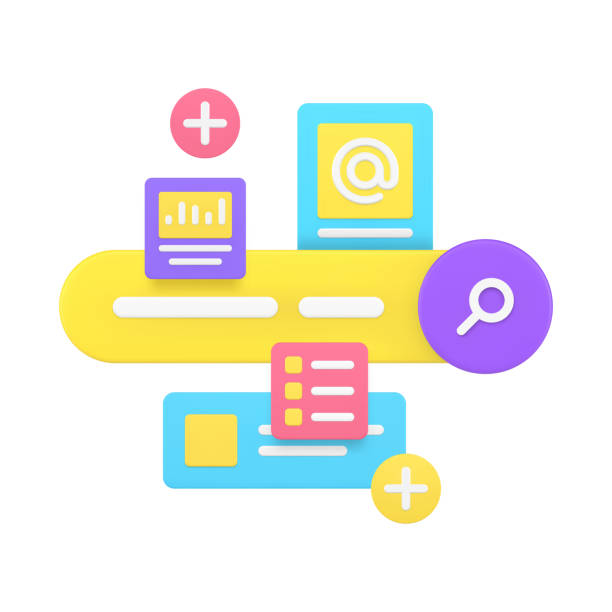Introduction to E-commerce Website Design and Its Importance in the Digital Age
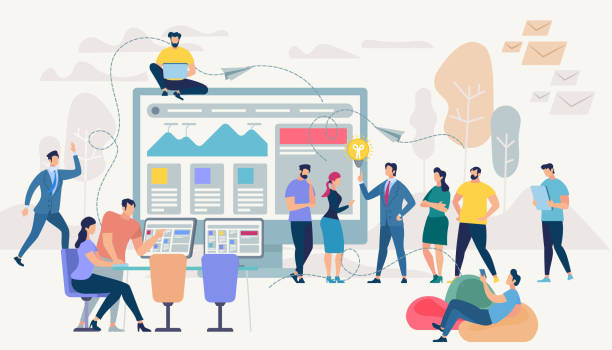
In today’s fast-paced world, an online presence has transformed from an advantage to a vital necessity for every business, especially for retailers.
#E-commerce website design is no longer just an option; it’s considered the backbone of growth and development strategy.
An efficient e-commerce website not only allows you to offer your products and services to a wider audience but also provides an unparalleled shopping experience for customers.
This digital platform removes geographical and time limitations, allowing you to operate 24 hours a day, 7 days a week.
From an explanatory perspective, creating an online store is not just about listing products; it involves creating a complete ecosystem for order management, customer communication, data analysis, and continuous optimization.
The importance of successful e-commerce website design lies in its ability to convert visitors into loyal customers and significantly increase sales.
This process requires a deep understanding of market and customer needs, and the implementation of appropriate technical and marketing solutions.
Without a powerful e-commerce website, competing in today’s market will be almost impossible.
Therefore, investing in e-commerce website development is a strategic decision for survival and growth in the future.
Are your e-commerce website visitors leaving before making a purchase? Don’t worry anymore! With Rasaweb’s professional e-commerce website design services, permanently solve the problem of not converting visitors into customers!
✅ Significant increase in conversion rates and sales
✅ Unique and attractive user experience
⚡ Contact us now for a free consultation!
Choosing the Right Platform for Ideal E-commerce Website Design
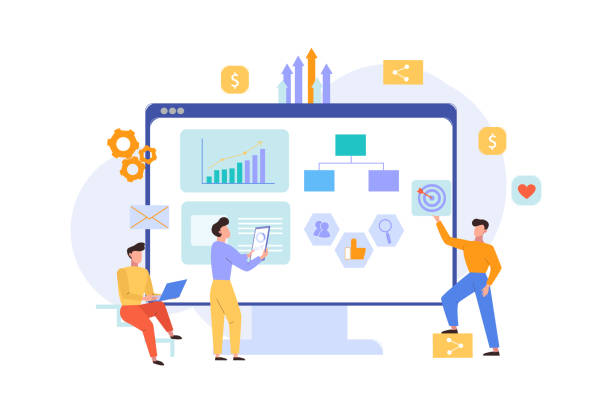
One of the essential steps in the e-commerce website design process is choosing the right platform.
This choice will directly impact the efficiency, scalability, and long-term costs of your project.
From a guidance and expert perspective, there are three main options available to you: ready-made platforms like WooCommerce (for WordPress) and Shopify, and custom development.
WooCommerce, due to its high flexibility and countless plugins, is a popular choice for small to medium-sized businesses looking for full control over their design and functionality.
Shopify is a SaaS (Software as a Service) solution that is simpler to manage and ideal for those with less technical knowledge.
However, with Shopify, you will have less control over the code and deeper customizations.
Custom development, though more costly and time-consuming, allows for the creation of a website perfectly aligned with your business’s specific needs and is suitable for large companies with unique requirements.
At this stage of e-commerce website design, you should consider factors such as budget, timeline, required features, product volume, and your team’s technical knowledge.
Each platform has its own advantages and disadvantages, and choosing the right one will be the foundation of a successful online store.
Key Elements in User Interface (UI) and User Experience (UX) Design for E-commerce Websites
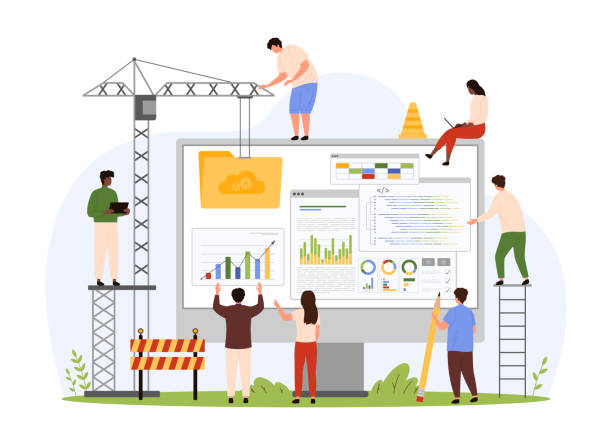
In the competitive world of e-commerce website design, simply having a good product is not enough; how that product is presented and the customer’s user experience are equally important.
User Interface (UI) and User Experience (UX) are two fundamental pillars in the success of any e-commerce website.
From an expert and educational perspective, an attractive and intuitive UI, alongside a smooth and frictionless UX, can make a significant difference in conversion rates and customer satisfaction.
Key UI elements include visual design (colors, fonts, images), easy and clear navigation, and responsive design for correct display on all devices.
On the other hand, UX focuses on the customer journey from the moment they enter the site until purchase completion.
This includes site loading speed, a simple and transparent payment process, complete and accurate product information, and efficient search functionality.
The table below compares some important UI and UX elements in online store creation:
| Element | UI Description | UX Description |
|---|---|---|
| Navigation | Clear and organized menus, recognizable buttons | Easy product finding, logical and confusion-free user flow |
| Product Pages | High-quality images, attractive information layout | Comprehensive and understandable information (descriptions, specifications, reviews), prominent “Add to Cart” button |
| Checkout Process | Clear and user-friendly form design | Simple, short, no extra steps required, diverse payment options |
| Loading Speed | Optimizing images and CSS/JS codes | Reducing user waiting time, preventing site abandonment |
These two aspects must be considered at every stage of e-commerce website design to ensure that customers can not only easily make purchases but also enjoy their experience and become loyal customers.
The Importance of SEO in E-commerce Website Design and How to Optimize It
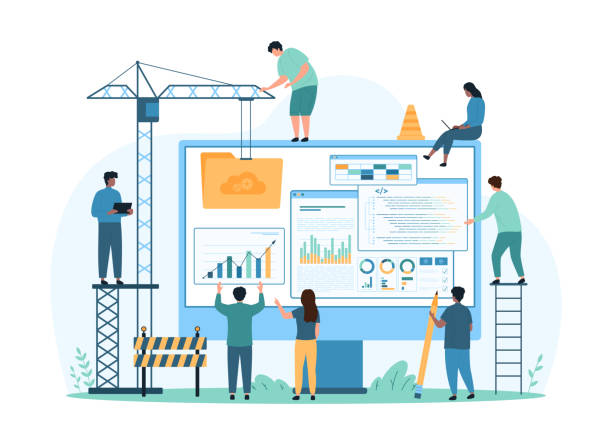
After e-commerce website design, it’s time for it to be seen.
Search Engine Optimization (SEO) plays a vital role in attracting organic traffic and increasing sales.
From an expert and guidance perspective, strong SEO ensures that your site appears higher in search results for keywords related to your products.
This means greater access to potential customers and reduced reliance on costly paid advertising.
During e-commerce website creation, attention should be paid to aspects such as keyword research, optimizing product content (descriptions, titles, and tags), optimizing images (compression and alt text), and creating SEO-friendly URL structures.
Additionally, site loading speed and responsiveness are crucial SEO factors evaluated by Google.
Using structured data (Schema Markup) to display more information in search results (such as price, availability, and reviews) can help increase click-through rates.
Proper internal linking between product pages and categories also helps search engines better understand your site’s structure.
Continuously analyzing SEO performance with tools like Google Analytics and Google Search Console is essential for identifying opportunities and improving rankings.
Are you tired of your company’s website not meeting your expectations? With Rasaweb, design a professional website that truly represents your business.
✅ Increased attraction of new customers and sales leads
✅ Enhanced brand credibility and trust among your audience
⚡ Get a free website design consultation!
Security in E-commerce Website Design: Protecting Customer Information

The issue of security in e-commerce website design is of paramount importance.
In a world where cyberattacks are becoming increasingly complex, protecting sensitive customer information and financial transactions builds and maintains their trust.
From a news and expert perspective, an insecure e-commerce website can quickly lead to loss of reputation, legal penalties, and a drastic reduction in sales.
The first step to ensuring security is using an SSL/TLS certificate, which encrypts communication between the user’s browser and the website server and displays your website address with HTTPS.
This is not only essential for security but also positively impacts SEO.
Choosing a reputable and secure payment gateway that complies with PCI DSS standards is the next step.
Additionally, you should regularly update your Content Management System (CMS) and used plugins and themes to prevent known security vulnerabilities.
Implementing a Web Application Firewall (WAF), regularly backing up data, and using strong passwords for all user accounts are other preventive measures.
Educating staff about security threats and how to identify phishing attacks is also crucial.
Finally, conducting regular penetration tests and monitoring suspicious activities on your website are an integral part of the security strategy in e-commerce website creation.
Methods to Increase Sales and Convert Visitors into Customers on E-commerce Websites

Success in e-commerce website design is not just about having a beautiful website, but about its ability to convert visitors into actual customers and increase sales.
From an analytical and guidance perspective, there are several strategies to achieve this goal.
Conversion Rate Optimization (CRO) is one of the most important, which involves improving site elements to encourage users to perform desired actions (like making a purchase).
Using clear and attractive Calls to Action (CTAs), displaying customer reviews and ratings (which increases trust), offering special discounts and promotions (such as free shipping for purchases above a certain amount), and creating a sense of urgency (by showing limited stock or remaining time for an offer) can be very effective.
Additionally, personalizing the shopping experience based on user behavior on the site (such as showing related products or suggestions based on purchase history) can significantly help increase sales.
Abandoned Cart Recovery tools are also essential for bringing back customers who haven’t completed their purchase process.
Providing diverse and easy payment options, as well as clear return and warranty policies, helps reduce customer hesitation.
Every step in e-commerce website development should be taken with the ultimate goal of increasing conversions and sales.
Integrating Analytics and Marketing Tools in E-commerce Websites

For your e-commerce website design to become a powerful sales machine, you need a deep understanding of customer behavior and site performance.
Integrating analytics and marketing tools makes this possible.
From an expert and educational perspective, Google Analytics is an essential tool that provides comprehensive information about site traffic, traffic sources, user behavior (such as visited pages, time on site, and bounce rate), and conversion rates.
By analyzing this data, you can identify your site’s strengths and weaknesses and take action to improve them.
In addition to Google Analytics, other tools such as Heatmap tools and Session Recording can provide deeper insights into how users interact with your pages.
In the field of marketing, integrating CRM (Customer Relationship Management) systems, email marketing tools (like Mailchimp or SendGrid), and advertising platforms (like Google Ads and Facebook/Instagram Ads) is crucial.
These tools help you create targeted marketing campaigns, communicate with your customers, and encourage repeat purchases.
For example, using email marketing, you can send welcome emails, personalized offers, and abandoned cart reminders.
CRM systems also allow you to track customer interaction history and provide better service.
These supplementary tools are an integral part of a comprehensive strategy after e-commerce website design that contributes to the sustainable growth of your business.
| Tool Category | Example Tools | Main Use in E-commerce Website |
|---|---|---|
| Analytics and Monitoring | Google Analytics, Hotjar, Google Search Console | Traffic analysis, user behavior, traffic sources, goal and conversion tracking, identifying SEO and UX issues |
| Email Marketing | Mailchimp, SendGrid, ConvertKit | Sending newsletters, promotional emails, abandoned cart recovery, automated campaigns |
| Customer Relationship Management (CRM) | Salesforce, Zoho CRM, HubSpot CRM | Customer information management, tracking purchase history, customer support, customer segmentation |
| Online Advertising | Google Ads, Facebook Ads Manager | Running Pay-Per-Click (PPC) campaigns, remarketing, social media advertising |
Continuous Maintenance and Updates for E-commerce Websites

E-commerce website design is just the starting point; its long-term success depends on its continuous maintenance and updates.
From an explanatory perspective, an e-commerce website, like any living organism, needs constant care and attention to maintain its optimal performance and stay ahead of competitors.
This process includes software updates (CMS, plugins, themes), regular checking for broken links and corrupted images, continuous site speed optimization, and regular backups of the entire site.
Security updates are also essential to protect against new cyber threats.
In addition to technical aspects, content updates are also highly important.
Adding new products, updating existing product descriptions, publishing relevant blog articles, and creating fresh content for SEO all help attract new customers and retain existing ones.
Lack of proper maintenance can lead to security issues, reduced speed, poor user experience, and ultimately, loss of search engine rankings.
Planning for continuous maintenance and optimization of the e-commerce website should be an integral part of your business strategy to ensure your website is always at its peak performance.
Are you losing business opportunities because of an outdated website? With Rasaweb, permanently solve the problem of not attracting potential customers through your website!
✅ Attract more high-quality leads
✅ Increase brand credibility in the eyes of customers
⚡ Get a free corporate website design consultation!
Common Challenges and Solutions in E-commerce Website Design and Management
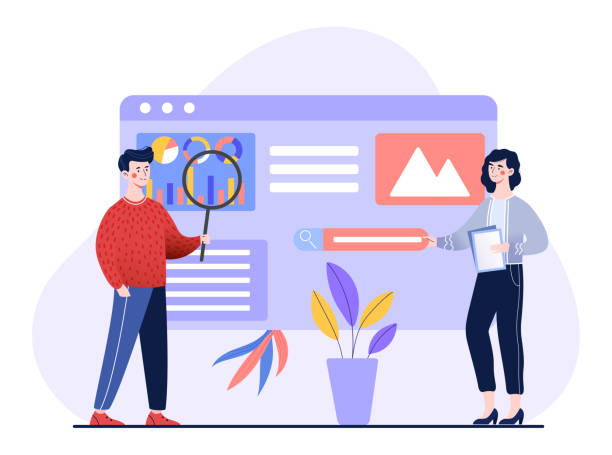
The process of e-commerce website design and its management comes with numerous challenges.
From a thought-provoking content perspective, are you ready for these challenges? One of the most common issues is choosing the right platform and technology that aligns with the business’s current and future needs.
The solution is to conduct a comprehensive analysis of your needs and goals and carefully compare different options before taking any action.
Another challenge is intense competition in the online market.
To overcome this challenge, you need to implement strong digital marketing strategies, including SEO, content marketing, and targeted advertising, and continuously strive to provide a superior user experience.
Security is also a major concern; cyberattacks can quickly jeopardize your reputation and data.
The solution is to invest in advanced security solutions, regular updates, and staff training.
Inventory management and logistics (shipping) can also be complex; optimizing these processes using warehouse management software and collaborating with reputable shipping companies is essential.
Furthermore, ensuring quick and effective customer support is vital for retaining their loyalty.
Your online store must constantly evolve to keep pace with market changes and customer expectations.
The Future of E-commerce Website Design and Emerging Trends

The world of e-commerce website design is rapidly evolving, and anticipating future trends is essential for survival and growth.
From an entertaining and analytical perspective, some of these trends are exciting and innovative.
Artificial Intelligence (AI) and Machine Learning (ML) will play an increasing role in personalizing the shopping experience, providing more accurate product recommendations, and improving customer support through advanced chatbots.
Augmented Reality (AR) and Virtual Reality (VR) will also allow customers to virtually try products in their real environment or view them in 3D spaces, which can significantly enhance the shopping experience.
Voice search, with the proliferation of smart devices, will become an important channel for product discovery, and e-commerce website design must be optimized for this type of search.
Sustainability and ethics have also become important decision-making factors for consumers; future e-commerce websites should have greater transparency regarding their supply chain, raw materials, and environmental impacts.
Furthermore, deeper integration with social networks for seamless shopping experiences (Social Commerce) and subscription models for products and services, are other important trends that e-commerce website developers should pay attention to.
These changes provide unparalleled opportunities for innovation and differentiation in the market.
Frequently Asked Questions
| Question | Answer |
|---|---|
| What is an e-commerce website? | A website that enables the online purchase and sale of goods or services. |
| What are the main features of a good e-commerce website? | Easy user interface, product categorization, shopping cart, secure payment gateway, search and filter capabilities. |
| What are the common platforms for e-commerce website design? | WordPress (WooCommerce), Shopify, Magento, PrestaShop, and… |
| Why is e-commerce website responsiveness important? | For proper site display on various devices (mobile, tablet, desktop) and to improve user experience and SEO. |
| What are the benefits of having an e-commerce website? | 24/7 customer access, reduced operational costs, access to a wider market, customer data collection. |
And other services of Rasaweb Advertising Agency in the field of advertising
Smart Marketplace: Designed for businesses seeking user engagement through precise audience targeting.
Smart Brand Identity: Designed for businesses aiming to increase website visits by optimizing key pages.
Smart Marketing Automation: A combination of creativity and technology to increase click-through rates through attractive UI design.
Smart UI/UX: A novel service for enhanced campaign management through custom programming.
Smart Marketplace: Revolutionize sales with the help of user experience customization.
And over hundreds of other services in the field of internet advertising, advertising consulting, and organizational solutions
Internet Advertising | Advertising Strategy | Advertorial
Sources
Step-by-Step Guide to E-commerce Website DesignHow Much Does It Cost to Design an E-commerce Website?Comparison of the Best Platforms for Building an Online Store10 Vital SEO Tips to Increase Your E-commerce Website Sales
? Ready to take your business to the top in the digital world? Rasaweb Afarin Digital Marketing Agency, with its expert and creative team, is always by your side to pave your path to success with innovative strategies and comprehensive services. From SEO and optimization to professional e-commerce website design, we are here to turn your digital dreams into reality.
📍 Tehran, Mirdamad Street, Next to Central Bank, Kazeroun Jonoubi Alley, Ramin Alley, Plaque 6

